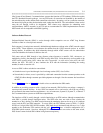5-2 ELECTRONIC TANDEM NETWORK (ETN) THROUGH THE ETN AND PNA PACKAGES
_ ___________________________________________________________________________________________________________________________
_ ___________________________________________________________________________________________________________________________
_ ___________________________________________________________________________________________________________________________
The characteristics of a hierarchical network (see figure 5-1) are:
• Each tandem switch has an assigned level (upper and lower).
• Each lower level switch connects to an upper level switch.
• Upper level switches are interconnected.
• A routing plan that prevents circular call routing.
The characteristics of a symmetrical network are:
• Tandem switches are of an equal level.
• All routes (trunk groups) are high usage.
• Circular call routing is prevented by limited tandem-to-tandem routing to the first several routes.
In figure 5-1, the hierarchical ranking of switches is shown. The ranking allows an orderly routing of on-
net access calls. The switching portion of the network is represented in figure 5-1 by the upper-level and
lower-level tandem switches connected by intermachine tie trunks. The tandem switches can accept
voice/data calls from any connected point and pass the calls to another connected point. The upper-level
switches handle heavy call volumes and the lower-level switches handle lighter volumes. Lower-level
switches can be administered to overflow to upper-level switches.
ETN TRUNKS
The trunks that connect the switches within the private network are named according to function. That is,
names like intermachine (intertandem), access, bypass access, and off-net denote functional (type of
routing) rather than hardware differences. (See the Trunking section of chapter 1 and administrative
details.) As its name implies, an intermachine tie trunk interconnects two tandem switches. It can be 1-
way incoming, 1-way outgoing, or 2-way. Intermachine tie trunks are further classified as primary high-
usage, intermediate high-usage, or final, depending on how blocked calls overflow from one trunk group to
another. How calls overflow is administered by designating routing patterns and trunk group preferences in
AAR.
The routing characteristics for intermachine tie trunks are as follows:
• Primary high-usage (PHU) intermachine tie trunks — These trunks serve first-choice traffic only. That
is, they do not receive any overflow traffic, but calls that they cannot handle may overflow to
intermediate or final trunk groups.
• Intermediate high-usage (IHU) intermachine tie trunks — These trunks serve first-choice traffic and
receive overflow traffic from primary high-usage trunk groups. They direct any overflow traffic to final
trunk groups.
• Final intermachine tie trunks — These trunks accept first-choice traffic and also receive overflow traffic
from primary and intermediate high-usage trunk groups. They do not redirect calls that they cannot
handle to any other trunk group. Depending on how the trunk is administered, when a call is blocked,
the caller receives busy or intercept tone or the call is placed in queue.
Refer to figure 5-2 for the types of overflow routing.


















